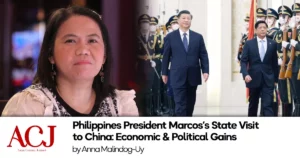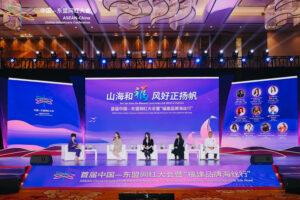THE Two Sessions, formally known as the National People’s Congress (NPC) and the Chinese People’s Political Consultative Conference (CPPCC), are the pinnacle of China’s political landscape. Held annually in March at the Great Hall of the People in Beijing, these gatherings are a powerful platform for shaping China’s legislative and political agenda for the year ahead.
Since the Chinese economy is the world’s second largest and plays a pivotal role in global trade, investment and financial markets, the outcomes of the Two Sessions, particularly the economic policies and targets announced, have significant implications for China and the global economy. This year, Two Sessions provided critical insights into China’s policy direction, with substantial implications for domestic and international stakeholders. The emphasis on economic targets, the unveiling of moderate stimulus plans and the strategic focus on key industries such as artificial intelligence and China’s “new quality productive forces” indicate China’s efforts to stabilize growth while navigating complex internal and external challenges.
Economic targetsand growth strategy
One of the most anticipated events of the Two Sessions is the government work report delivered by Premier Li Qiang. This report outlines the administration’s achievements over the past year and sets economic targets for the coming year. For 2024, key economic objectives highlighted were expected to include achieving steady growth, focusing on around 5-percent gross domestic product (GDP), and maintaining a budget deficit of 3 percent of GDP, indicating a cautious fiscal stance aimed at stabilizing the economy while addressing structural imbalances.
Note that despite external pressures and internal difficulties, the Chinese economy showed signs of rebound and improvement last year. China achieved its major economic targets for 2023, with its GDP expanding by 5.2 percent, surpassing the target GDP growth of 5 percent for that year.
Thus, as far as China’s 2024 GDP growth target — set at around 5 percent — is concerned, it is a significant marker of the country’s economic trajectory. It reflects the government’s strategic emphasis on stability and growth while recognizing the need for proactive actions to transform China’s growth model, focusing more on high-quality development than speed. This target, though modest compared to historical growth rates, including the pre-pandemic period when the Chinese economy grew by at least 6 percent to 10 percent annually, clearly indicates that Chinese leadership recognized some of China’s challenges. These challenges include weak property and private sector growth, and soft domestic consumption, which are being addressed strategically by the Chinese government.
Furthermore, China’s 5-percent target GDP growth in 2024 is a testament to China’s realistic, prudent, calibrated approach to economic management and policymaking aimed at ensuring stability, more sustainable and steady growth without overheating the economy. This also reflects a more cautious approach that balances the need for stability while acknowledging existing economic challenges and the importance of realistic goal-setting at both the national and local levels. It underscores the resilience of the Chinese economy in the face of challenges.
Maintaining a budget deficit of 3 percent of GDP, on the other hand, is another sign of prudent fiscal policy. It suggests that while the government is willing to spend to stimulate the economy and invest in key areas, it is also mindful of not accumulating excessive debt, which could become unsustainable in the long term. This level of deficit is said to be manageable and geared toward balancing the need for government spending with fiscal responsibility.
Indeed, the Chinese leadership’s calibration of economic policies demonstrates not only a sound management strategy to balance growth with stability but also suggests a focus on long-term economic health over short-term gains, a prioritization of sustainable development and an awareness of the need to mitigate potential risks that could arise from internal imbalances and external economic pressures.
Tech-driven and eco-friendly
In achieving the set of economic targets this year, China appears focused on promoting the so-called new quality productive forces and strategic industries like artificial intelligence and green technology, indicating a long-term vision for transforming the Chinese economy into a high-tech powerhouse.
Note that the tech-intensive green trio of solar batteries, lithium-ion batteries and electric vehicles have become the top drivers of China’s foreign trade, indicating a shift toward a more sustainable, eco-friendly and innovation-driven economy. In 2023, China became the world’s largest car exporter, surpassing Japan for the first time. The increase in overseas sales of electric vehicles contributed to this achievement.
Undoubtedly, China’s efforts are geared toward developing a technology-driven and eco-friendly economy that could substantially impact domestically and globally. The country has been proactively investing in clean energy technology and making strides in industries that align with its “dual carbon” goals, which aim to peak carbon dioxide emissions before 2030 and achieve carbon neutrality before 2060.
On the other hand, China’s “new quality productive forces” concept represents a forward-thinking approach to economic development. By emphasizing science and technology, the digital economy and green technologies such as electric vehicles, China is signaling a commitment to innovation and sustainable development. By investing in these areas, China is positioning itself at the forefront of cutting-edge developments that can transform industries.
The digital economy encompasses e-commerce, cloud computing, big data and artificial intelligence. China’s focus on these areas can boost its domestic economy and global competitive edge. On the other hand, prioritizing green technologies, particularly electric vehicles, is a strategic response to environmental concerns and the global shift away from fossil fuels. This not only caters to internal demands for cleaner air and energy but also positions China as a leader in the rapidly growing global market for green technology.
Likewise, by focusing on these “new growth drivers,” China acknowledges that sustainable growth is not just about the current economic output but also about the long-term health of its environment and society. More importantly, China’s largest market, with its manufacturing capabilities, will likely emphasize new productive forces that will influence global trends, potentially lowering costs and increasing the adoption rate of these technologies worldwide.
In essence, China’s designation of science and technology, the digital economy and green technology as “new productive forces” reflects an adaptive strategy to reconcile rapid economic development with environmental sustainability and technological progress. If China succeeds in this endeavor, it could set a precedent for how the economies of the Global South can transition to new growth paradigms in the 21st century.
On a global scale, China’s push toward a greener economy is advancing its domestic technology and industry sectors, and creating opportunities for international collaboration and investment. Expanding China’s green industries provides a fertile ground for global businesses to engage with and benefit from this transition.
Likewise, China’s green technologies and policies are extending benefits beyond its borders, offering solutions and support to countries pursuing their own sustainable development goals. For instance, China’s investments in solar power plants in Africa and the supply of electric buses to South American cities illustrate this point.
Overall, China’s endeavor to mold its economy to be more technology-driven and environmentally friendly is poised to impact the global stage profoundly. It reinforces the role of sustainable practices in economic development and highlights the potential for green technologies to drive future growth. This shift exemplifies China’s commitment to reducing carbon emissions and sets a precedent for other nations to prioritize green and sustainable economic development strategies.
Source: The Manila Times
https://www.manilatimes.net/2024/03/16/opinion/columns/two-sessions-2024-deciphering-chinas-economic-strategy-and-how-it-shapes-global-dynamics/1936972



